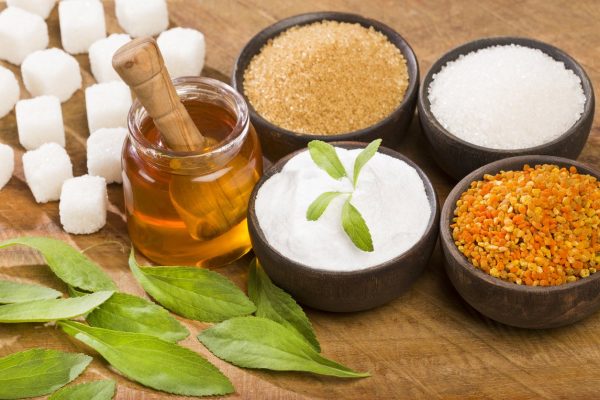Other than Disney World, Pinterest is my most favorite place on earth. I lose about two hours of my life each time I dive into that site and search for new recipes for my healthy lifestyle. I used to get into what looked like the perfect recipe and have to back right out after seeing ingredients like refined sugar, bread crumbs, all-purpose flour, vegetable oil, etc. To say that finding a zucchini fritter recipe with all purpose flour listed as an ingredient was a kick to the gut would be an understatement. But then I walked into Forum Health and learned how to keep that recipe by making a few healthy substitutions. Now my Pinterest time hasn’t decreased by any means, but my disappointment certainly has. With a little education, I now know how to swap out the bad for the good and make my favorite recipes even better!
Most of the clients who walk through our doors are quite fearful of the healthy switch—not because they’re afraid of change, but because they’re afraid that they won’t know how to make that change. Once they get into a groove, however, they begin to learn. That’s the best part of what we do here at Forum Health — we teach lifelong lessons that eventually just become a way of life.
Gluten Free Substitutes…

Gluten-free Flour for Wheat Flour:
This is an easy switch. My favorite brand is Bob’s Red Mill; however, any gluten-free brand will work. When a recipe calls for flour, whether it be cookies and other baked goods or dinner, don’t think you have to cut your losses and walk away. There are a TON of alternatives to that one pesky ingredient.
- Coconut Flour: High in fiber, protein and healthy fats, this gluten-free flour is free from wheat and other grains. It’s also low in sugar, digestible carbohydrates and calories, and has a low score on the glycemic index.
- Almond Flour: Made up of raw, blanched almonds that are ground down into a fine flour, this and other nut flours such as chestnut and hazelnut, macadamia and pistachio add protein and a vibrant taste to gluten-free baking.
- Tapioca Flour/Starch: Its starchiness makes it an excellent gluten-free flour, but it must be used in combination with other flours to make great baked goods.
- Arrowroot: Best used as a thickener, for a nice roux or sauces, and fillings for fruit pies. People who are allergic to corn are especially grateful for the existence of this starch.
- Oat Flour: Very similar taste to wheat flour, but somewhat heartier and sweeter. Although oat flour is a bit hard to find, it’s easy to make at home by putting rolled oats in a food processor or blender and pulsing until you get a fine powder.
Black Beans for Flour: Give yourself an extra dose of protein. Swap out a 15 oz. can (rinsed and drained) of organic black beans, pureed, per one cup of flour in brownies. WHAT?!? I know. Just try it. You won’t be sorry.
Quinoa for Couscous: Quinoa is a whole-grain superfood while couscous is made from processed wheat flour. Same texture, packed with protein and nutrients. #winning
Spaghetti Squash for Pasta: Roast it in the oven or even the microwave if you’re in a time crunch, once you pull the inside apart with a fork, you’ll see (and taste!) exactly why it’s a low-carb substitute for pasta. Make it hot or cold. I even have a friend who puts a little butter (grass fed) and cinnamon (organic) on hers. Give it a try!
Zoodles for Pasta: I love my spiralizer. I want to spiralize everything in my path. GoodGrips has a great handheld one that I swear by. I make zoodles in every flavor: butternut squash, sweet potato, zucchini, and yellow squash. These wonderful strips or ribbons are carb free and gluten free, and they can substitute any noodle for your favorite hot or cold pasta.
Lettuce Wraps for Tortillas: If the insides are flavorful, you won’t need that carb-dense tortilla wrap on the outside. Load up your tacos with organic seasonings, black beans, tomatoes, organic cheese, and sour cream (or Greek yogurt) , and give it a nice crunch on the outside with some fresh lettuce.
Veggies for Pita: Ditch the pita and use fresh veggies such as peppers, cucumbers, celery, or broccoli to dip into your favorite hummus.
Nuts for Croutons: We all love that extra crunch in our salad, but it doesn’t have to be a dried piece of bread that gives us that satisfaction. Swap out the croutons for a dose of healthy fats like slivered almonds, pecans, or walnuts.
Potato Buns: This is a great way to enjoy a burger or sandwich, guilt free. Slice a wide potato into ½ inch thick rounds. Bake them at 350 degrees for about 20 minutes for that carb-dense feeling.
Ground/Milled Flaxseed for Bread Crumbs: Filled with fiber, omega 3’s, and a ton of other healthy components, this super seed has a slight nutty flavor and is great as a breading on chicken or fish.
Sugar Substitutes

Raw Honey: There are so many benefits to this golden sweetener, like warding off infections, providing natural allergy relief, and boosting overall immunity. Its natural sugars make it the perfect running fuel. Make sure it’s raw because that’s the healthiest kind. Just be sure to use it sparingly because too much of a good thing can turn bad.
100% Pure Maple Syrup: This sweetener is derived from the sap from maple trees. Look for grade B or grade C USDA certified organic. With a lower score on the Glycemic Index, maple syrup supplies some trace minerals and antioxidants.
Organic Dates: High in fiber and potassium, dates are great for baking. These little natural sweeteners have been known to decrease cholesterol, relieve constipation, and boost energy.
Stevia: Good, especially with blood sugar issues, weight issues, or diabetes. Stevia is a no calorie, all natural sweetener that comes from the leaf of a flowering plant. The best form of stevia to look for is green leaf stevia.
Coconut Sugar: Unrefined, vegan, non-GMO, this replacement is great for baking. It scores very low on the Glycemic Index and is full of potassium, electrolytes, and nutrients.
Butters and Oils

Coconut Oil: This substitute is my go-to for multiple reasons. Not only does it keep the brain healthy and reduce inflammation, it also supports the heart, kidneys, immune system, skin, hair, and it fights cancer. Ay-Ooooh! It’s also delicious, so there’s that.
Olive Oil: To stick to a vegan diet, try olive oil instead of butter.
Mashed Avocado: Just like butter, avocado is a fat and has the same creamy consistency when mashed. If butter isn’t in your diet, try an avocado. It works in desserts, too!
Other Healthier Options
Cacao Nibs for Chocolate Chips: Nibs are the roasted part of the cocoa beans that get ground down into chocolate. They’re what your chocolate chips start as before they lose their antioxidant properties through getting processed with all those added sugars.
Organic Wheat Flour: When wheat isn’t organic this usually means that it’s been sprayed with roundup—a very toxic herbicide that is banned from being used with certified organic products. You’ll want to choose an organic flour that’s made with whole white wheat (not bleached), which has a light texture for cooking and baking. Sprouted flour is easier to digest than the starchier flours and your body is able to absorb the nutrients, which is good because it’s loaded with antioxidants and vitamins. Thrive Market has a great organic sprouted white wheat flour on their website.
Food Coloring: Stay away from the artificial dyes made from petroleum to avoid several health issues and allergies. Swap out the McCormick and Betty Crocker boxes in your pantry for natural vegetable colorants made from real food like beets, spirulina, and turmeric that don’t have chemicals linked to breast cancer in them. Try India Tree Nature’s Colors Decorating Set.
Greek Yogurt for Sour Cream or Mayo: All it takes is a little lemon juice and some herbs to turn plain Greek yogurt into your favorite sandwich spread without all the oils.
Pureed Fruit for Syrup: Lose the processed sugar for pureed raspberries, blueberries, or strawberries warmed on the stove to pour over your favorite pancakes and waffles.
Coconut Milk for Cream: This is a great substitute for heavy cream (extra fat) in soups and stews. It isn’t sweet like the shredded flakes you bake with, so your dinner won’t taste like candy!
Black Rice for White or Brown Rice: This is the less popular rice that many people don’t even know exists, which is sad because it’s LOADED with health benefits like antioxidants, fiber, iron, and more protein than any other rice out there. Not to mention, it’s quite tasty!
Steamed Cauliflower for Rice: Many people are confused about this. It isn’t necessarily a “healthier” swap because rice does have many benefits. However, if you want to cut back on carbs, try some cauliflower rice. There are many recipes on Pinterest that can help you make the perfect side dish.
Nutritional Yeast for Cheese: A favorite in the Vegan community for its nutty, cheesy flavor, this substitute is rich in protein and low in fat. Try it on salads, tacos, pastas, or anything else that needs that cheesy satisfaction!
Final Thoughts…
It’s always good to make a healthy change. On the other hand, you want to know what you’re doing and why. While it’s always a good idea to cut out gluten, the best way you could ever help yourself is to know why and how without the dangerous processed alternatives. Before you can do any of that, you must get to know your body. We are happy to help you with that, to not only introduce you to yourself but to lifelong health and vitality.









